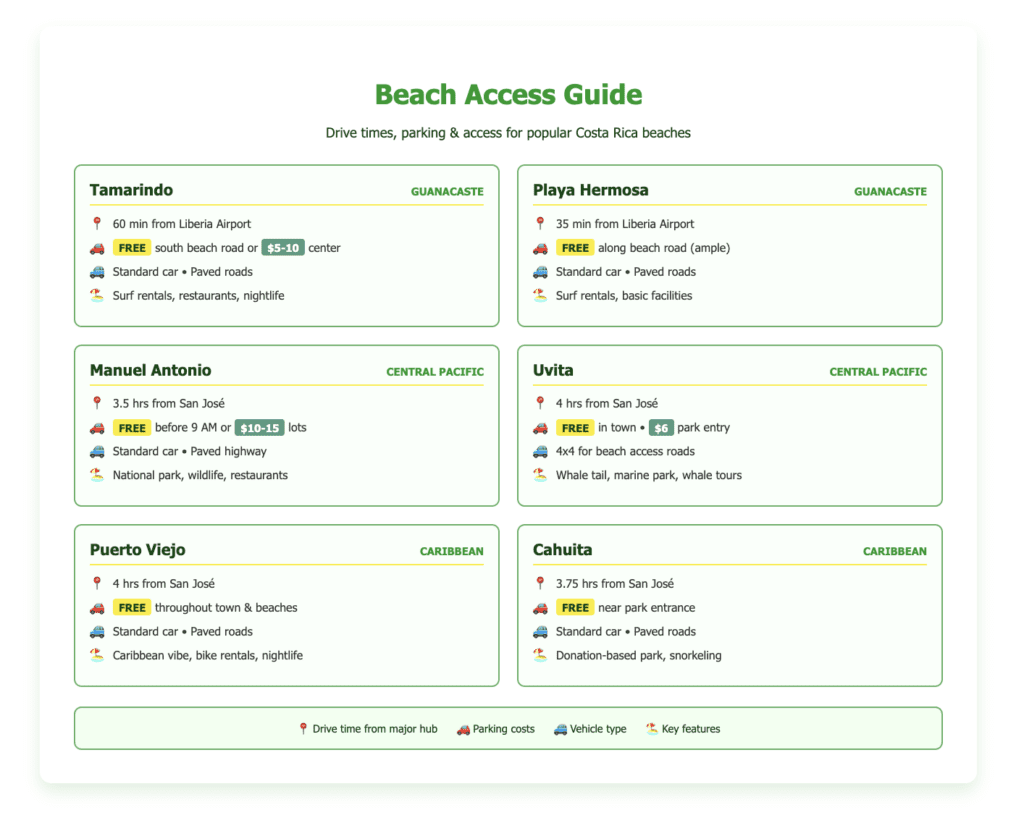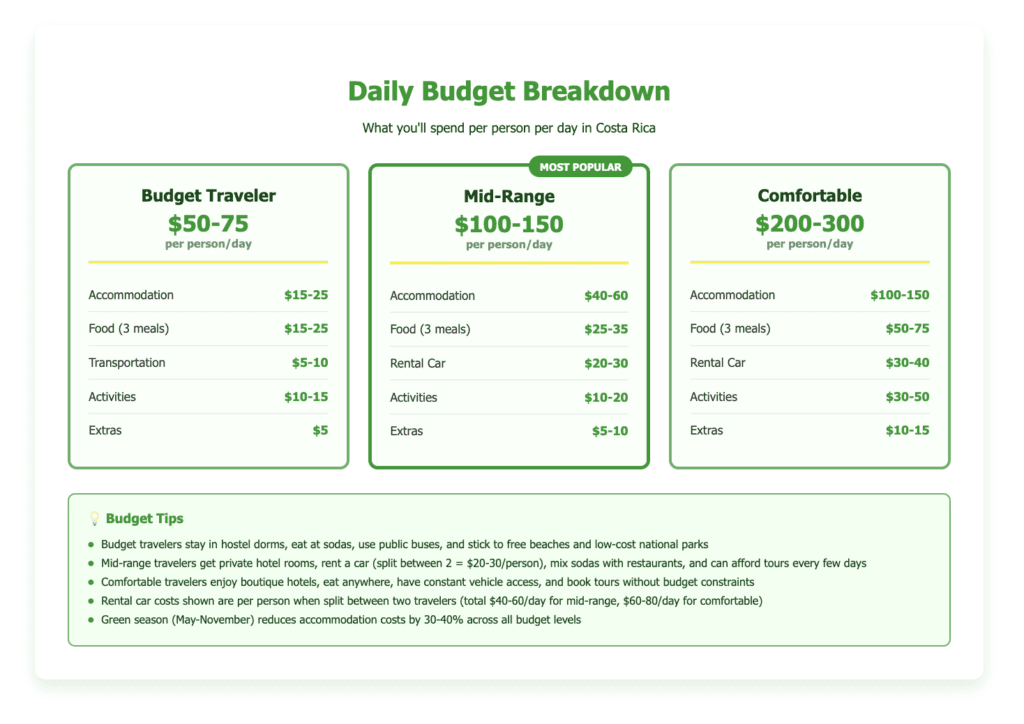Budget-Friendly Costa Rica: What's Covered
Costa Rica’s best budget experiences combine free public beaches, national parks under $20, and local sodas serving $5-8 casados. From Cahuita’s donation-based park to free crocodile viewing at Tarcoles Bridge, you’ll find world-class nature without the premium price tags. A rental car from Vamos unlocks remote free beaches and lesser-known parks where buses don’t reach, while splitting the $40-60 daily cost between two travelers beats shuttle prices.
Quick Facts:
- All Costa Rica beaches are public and free by law – no entrance fees ever
- National parks charge $12-20 versus $40-75 at private reserves
- Green season (May-November) cuts accommodation costs by 30-40%
- Local sodas serve filling casados for $5-8 (look for Spanish-only menus)
- Morning wildlife viewing (6-8 AM) costs nothing extra but triples sightings
Top Budget Experiences:
- Cahuita National Park – Caribbean coast park operating on a donation basis with 8km of coastal trails and reliable sloth sightings.
- Tarcoles Bridge Crocodiles – Free viewing of massive American crocodiles from the bridge, 90 minutes from San José.
- Local Farmers’ Markets – Weekend ferias offer free cultural immersion and tropical fruit samples under $2.
- Manuel Antonio Beaches – Four pristine beaches inside the $16 park, plus free public beaches outside park boundaries.
- Poás Volcano – Active crater viewing for $15, just 90 minutes from San José with no overnight stay needed.
Having your own transportation transforms budget travel – that remote beach mentioned by locals becomes accessible without paying $80-100 for guided tours.
If you need any help with a Costa Rica car rental, contact us now!
Costa Rica has a reputation for being pricey, but you can absolutely experience this incredible country without emptying your wallet. The secret lies in knowing where to find value: national parks with entrance fees under $20, hundreds of kilometers of free public beaches, self-guided hikes through pristine forests, and local sodas serving authentic meals for $5 to $8. With a rental car unlocking access to remote free beaches and lesser-known parks, strategic meal choices at local spots instead of tourist restaurants, and smart timing to visit during the more affordable green season, you’ll discover that Costa Rica rewards travelers who plan thoughtfully.
Key Takeaways
- National park entrances range from free to $20, offering world-class nature experiences at a fraction of private reserve costs.
- All beaches in Costa Rica are public and free to access, from Caribbean shores to Pacific sunsets.
- A rental car saves money by accessing free attractions and eliminating expensive guided tour transportation.
- Local sodas serve filling casado meals for $5-8 compared to $15-30 at tourist restaurants.
- The green season (May-November) offers 30-40% lower accommodation costs with fewer crowds.
- Self-guided experiences like hiking and beach days cost nothing beyond park entrance fees.

What Are the Best Free Things to Do in Costa Rica?
Costa Rica’s greatest treasures don’t require an entrance fee. Every beach in the country remains public by law, meaning you have free access to hundreds of kilometers of coastline on both the Pacific and Caribbean sides. You’ll spend nothing to walk Tamarindo’s golden sands at sunset, swim in Puerto Viejo’s turquoise waters, or explore the tide pools at Playa Conchal.
Beyond beaches, you’ll find free viewpoints throughout the country that rival any paid attraction. El Miro near Jacó offers sweeping Pacific views after a 30-minute hike up a well-maintained trail. The drive from Liberia takes about 90 minutes on paved roads, making it an easy addition to any Guanacaste itinerary. Park at the trail entrance (free) and bring water for the moderately steep ascent.
The farmers’ markets (ferias) provide another cost-free cultural experience. These weekend gatherings let you sample fresh tropical fruits, watch locals bargain in Spanish, and soak up authentic Costa Rican culture. San José’s Zapote neighborhood hosts a massive Friday-Saturday feria, while smaller towns throughout the country set up their own weekend markets. You’ll pay nothing to wander and people-watch, though you might be tempted to buy some of the freshest pineapple you’ve ever tasted for under $2.

Which National Parks Offer the Most Value for Money?
National parks represent Costa Rica’s best budget-friendly investment. For $15-20, you’re getting access to protected rainforests, volcanic landscapes, and wildlife viewing that private reserves charge $40-75 to experience. Rincón de la Vieja National Park costs $15 for foreigners and delivers bubbling mud pots, waterfalls, and hiking trails through dry tropical forest. The drive from Liberia Airport takes 90 minutes on well-maintained roads (no 4×4 required during the dry season).
Manuel Antonio National Park charges $16 and remains the country’s most visited park for good reason. Four pristine beaches sit within park boundaries, and you’ll spot sloths, monkeys, and colorful birds without hiring a guide. Arrive when gates open at 7 AM to beat crowds and secure parking ($10 for the day). The park sits 3.5 hours south of San José via paved highway, making it accessible in a standard vehicle year-round.
Cahuita National Park on the Caribbean coast operates on a donation basis. While officially requesting a contribution, you’re welcome to pay what you can afford. The 8-kilometer coastal trail winds through coastal rainforest where howler monkeys call from the canopy and sloths hang motionless in cecropia trees. You’ll reach Cahuita from Puerto Viejo in 30 minutes, heading north on coastal Highway 36.
How Do Park Costs Compare to Private Reserves?
Private reserves typically charge 2-3 times more than national parks. Monteverde Cloud Forest Reserve costs $25 for adult admission, while nearby Santa Elena Cloud Forest Reserve (also private but community-run) charges $18. Both offer similar misty forest experiences with hanging bridges and guided trails. National parks maintain lower prices through government subsidies, making them the smarter choice for budget-conscious travelers who don’t need luxury amenities.
The quality of experience doesn’t suffer in national parks. You’re seeing the same wildlife, hiking through equally pristine forests, and often encountering fewer crowds since private reserves concentrate visitors in smaller areas. Save your splurge budget for one special experience like the Monteverde ziplines, and stick to national parks for your nature fix.

How Can You Experience Costa Rica’s Beaches Without Breaking the Bank?
Beach days cost exactly zero colones once you arrive. Pack a cooler with snacks and drinks from a local supermarket (budget $15-20 for a day’s supplies for two people), grab your beach gear, and head to the sand. Playa Hermosa in Guanacaste stretches for over a kilometer of gray sand perfect for surfing and sunset walks. You’ll find free street parking along the beach road, though spaces fill up by late morning on weekends.
The Caribbean side offers a completely different vibe without a different price tag. Playa Cocles near Puerto Viejo features powerful surf, golden sand, and that laid-back Caribbean atmosphere. Drive 5 minutes south of Puerto Viejo’s center and park along the road for free. Bring your own food since beachside restaurants charge tourist prices, but do grab a fresh coconut from a vendor ($2-3) for the full experience.
Surfboard rentals run $15-25 for the full day, and many beach towns offer multiple rental shops competing for your business. In Tamarindo, you’ll find better rates by walking two blocks inland from the main beach area, where shops target locals rather than tourists. Boogie boards rent for even less ($5-10), perfect if you’re just learning to read waves.
Where Can You Find Free Parking at Popular Beaches?
Parking strategies save you $5-15 daily. Manuel Antonio’s public beaches (outside the national park) offer free street parking if you arrive before 10 AM. Later arrivals pay $10-15 at private lots near Playa Espadilla. In Tamarindo, free parking exists along the southern end of the beach road past the main commercial area, requiring a 5-minute walk to central spots.
Smaller beach towns rarely charge for parking. Sámara, Montezuma, and Uvita all offer free parking within walking distance of their beaches. The trade-off? Fewer amenities and longer drives from major airports. Uvita sits 4 hours from San José, but that drive unlocks Marino Ballena National Park ($6 entrance) and the famous whale tail formation visible at low tide.

Where Can You Find Affordable Wildlife Viewing Opportunities?
Wildlife doesn’t respect boundaries between expensive lodges and public areas. You’ll spot the same sloths, monkeys, and toucans on national park trails that guests at $300/night ecolodges see from their breakfast tables. The trick lies in knowing when and where to look. Early morning (6-8 AM) offers peak wildlife activity as animals forage before the heat sets in.
Manuel Antonio National Park delivers reliable wildlife sightings for that $16 entrance fee. Walk slowly, scan the canopy, and you’ll likely spot three-toed sloths hanging motionless in trees along the Sloth Trail. White-faced capuchin monkeys patrol the beaches looking for dropped snacks, while iguanas bask on sun-warmed rocks. Hiring a naturalist guide costs $20-25 per person and dramatically increases your chances of spotting camouflaged creatures, but it’s not essential if you’re patient and observant.
The Tarcoles River Bridge on Highway 34 between San José and Jacó offers free crocodile viewing. Pull into the roadside parking area (space for 10-15 cars) and walk onto the bridge. Look down into the murky water below and you’ll see massive American crocodiles lounging on the riverbanks. Visit during low tide when crocodiles gather on exposed mud flats. The bridge sits 90 minutes from San José toward the Pacific coast.
What Time Should You Visit for the Best Wildlife Sightings?
Dawn and dusk transform into animal rush hour. Arrive at park gates when they open (typically 7-8 AM) to catch wildlife during their most active period. You’ll also beat tour groups that arrive mid-morning after hotel pickups and breakfast service. This timing advantage costs nothing but sets your alarm earlier.
The afternoon brings different species. Birds become active again around 3-4 PM as temperatures cool, and you might spot nocturnal creatures beginning to stir. Staying until parks close (usually 4 PM) means you’re experiencing two distinct wildlife windows in a single admission.

What Are the Best Budget-Friendly Day Trips from Major Destinations?
Day trips from San José open up volcano experiences without overnight accommodation costs. Poás Volcano National Park sits 90 minutes north via winding mountain roads (standard vehicle acceptable during dry season). The $15 entrance includes viewing the active crater, walking forest trails, and exploring the visitor center. Pack a lunch from a San José supermarket ($8-10 for two) rather than paying inflated prices at the crater-side café.
Irazú Volcano, Costa Rica’s highest active volcano, lies 60 minutes east of San José. At $15 entry, you’ll stand at 11,260 feet looking into a crater that occasionally fills with an otherworldly green lake. The high altitude means cooler temperatures (bring a light jacket) and dramatically different vegetation from lowland areas. Both volcanoes make excellent half-day trips, letting you return to your San José accommodation rather than paying for hotels in smaller mountain towns.
From Liberia, Rincón de la Vieja National Park provides a full day of exploration, 90 minutes away. Beyond the park’s $15 entrance fee, you’re spending only gas money ($10-15 round trip) and whatever you packed for lunch. The park’s two trail systems offer everything from volcanic mud pots to waterfall swimming holes, easily filling 4-5 hours.
How Does Self-Guided Exploration Compare to Organized Tours?
Tour companies charge $65-95 per person for day trips that include the same national parks you can visit independently. That price covers transportation, guide services, and lunch, but you’re paying a significant premium for convenience. A rental car from Vamos gives you the flexibility to leave when you want, spend as long as you’d like at each spot, and explore at your own pace while saving $100-150 for a couple on a single day trip.
The downside? You’re responsible for navigation and might miss some wildlife without a trained naturalist’s eye. For budget travelers, the solution splits the difference: visit parks independently but hire a local guide once you’re there. Many parks have guides waiting at entrances who charge $20-30 per person for 2-3 hour walks. You get expert knowledge without paying for the transport markup.

How Much Should You Budget for Food and Transportation?
Food costs vary wildly based on where you eat. Tourist restaurants in places like Tamarindo, Manuel Antonio, and Monteverde charge $15-30 per entrée, not including drinks or tips. Walk three blocks away from the main tourist zones and you’ll find sodas frequented by locals where a casado (traditional plate with rice, beans, protein, salad, and plantains) costs $5-8 and fills you completely.
Look for sodas with Spanish-only menus and customers speaking Spanish to each other. These aren’t hidden secrets requiring insider knowledge—they’re simply the places locals eat because the food tastes like home and the prices reflect Costa Rican salaries rather than tourist budgets. Soda Tapia in San José or Soda Viquez near Jacó serve identical food quality to fancy restaurants at one-third the price.
Transportation between destinations on public buses costs $2-15, depending on distance, but buses add significant time. The San José to Manuel Antonio journey takes 4+ hours on a bus, making multiple stops, versus 3 hours in a rental car driving directly. For a week-long trip hitting three destinations, you’ll spend roughly the same on a rental car as you would on bus tickets, but you’ll gain flexibility and save hours of transit time.
What Does a Realistic Daily Budget Look Like?
Budget travelers managing on $50-75 per day stay in hostel dormitories ($15-25), eat at sodas for all meals ($15-25 total), use public buses ($5-10), and stick to free beaches and low-cost national parks ($10-15 when visiting paid parks). This budget requires discipline and doesn’t include any tours or adventure activities beyond park entrance fees.
Mid-range travelers spending $100-150 per day afford basic hotel rooms or nice hostels with private rooms ($40-60), eat one meal at a soda and one at a mid-range restaurant ($25-35 total), rent a car for flexibility ($40-60 daily including gas and insurance), and have budget remaining for one paid activity or tour every few days. This range delivers comfortable travel without constant penny-pinching.
A rental car shifts these calculations significantly. The $40-60 daily cost replaces bus tickets, expensive shuttle transfers, and some tour costs since you’re accessing remote locations independently. For two travelers splitting costs, a rental car often proves cheaper than paying two fares on shuttles between destinations.

Which Adventure Activities Offer Good Value?
Surfing lessons at $45-60 per person for 2 hours provide solid value. You’re getting instruction, board rental, and guaranteed wave-catching under an experienced teacher’s guidance. Compare this to a zipline canopy tour at $60-90 per person for a similar time investment. Both deliver memorable experiences, but surfing lessons give you a skill you can practice the rest of your trip for just the cost of board rentals ($15-25 daily).
Waterfall hikes cost only the entrance fee to reach them. La Fortuna Waterfall charges $18 to access the 500-step trail down to the swimming area, but you’re looking at one of Costa Rica’s most impressive cascades up close. Nauyaca Waterfalls near Dominical costs $9 for the 4-kilometer hike, delivering two stunning waterfalls and swimming holes. Pack your own snacks and water to avoid paying tourist prices at entrance areas.
Snorkeling gear rents for $10-15 per day, turning any calm-water beach into an underwater adventure. The Caribbean coast around Cahuita offers excellent snorkeling right from shore, with coral reefs starting just 30-50 meters out. You’ll see tropical fish, rays, and occasionally sea turtles without booking a $75 boat tour.
When Should You Splurge vs. Save?
Save on activities you can do independently with minimal equipment. Beach time, hiking, wildlife watching, and driving scenic routes cost almost nothing once you’re in Costa Rica. Splurge on experiences requiring specialized equipment or access you can’t arrange yourself. A whitewater rafting trip down the Pacuare River ($99-120) includes all gear, transport, and a professional guide navigating Class III-IV rapids through a pristine rainforest gorge. You can’t replicate that independently.
The same logic applies to meals. Eat casados and gallo pinto for most meals to save money, but splurge on one nice seafood dinner in a coastal town to taste fresh-caught mahi-mahi prepared by a skilled chef. Budget travel doesn’t mean eliminating all treats—it means choosing them strategically.

Where Can You Find Free or Low-Cost Cultural Experiences?
San José’s museums offer surprising value. The Jade Museum charges $15 and houses the world’s largest collection of pre-Columbian jade, while the Gold Museum costs $11 and sits in a stunning underground vault showcasing ancient gold artifacts. For context, you’re paying less than you’d spend on lunch at a tourist restaurant to access world-class cultural collections explaining Costa Rica’s indigenous heritage.
Churches throughout the country welcome respectful visitors free of charge. The Cartago Basilica attracts pilgrims year-round and features beautiful architecture and religious artwork. Zarcero’s garden church combines topiary art with religious history, creating a unique photo opportunity and cultural experience requiring no entrance fee. Simply dress modestly and enter quietly if services are ongoing.
Free walking tours operate in San José on a tips-only basis. Guides work for gratuities, meaning you pay what you feel the tour was worth ($10-15 per person represents typical appreciation). These 2-3 hour walks cover downtown highlights, historical context, and local recommendations from knowledgeable guides who know the city intimately.
How Can You Experience Local Life Without Tourist Markup?
Shop where locals shop. Municipal markets sell fresh produce, prepared foods, and souvenirs at local prices. San José’s Mercado Central buzzes with vendors selling everything from fresh coffee beans to handmade hammocks. You’ll pay local prices and experience authentic market culture simultaneously. Bring small bills in colones rather than US dollars for better exchange rates.
Time your visits around local festivals and events that welcome visitors without charging admission. Each town celebrates its own patron saint with festivals featuring parades, traditional dancing, and food vendors. These aren’t manufactured for tourists—they’re genuine community celebrations where you’re welcome to join the fun.
What’s the Best Way to Get Around Costa Rica on a Budget?
Public buses work for ultra-budget travelers with flexible schedules and minimal luggage. A San José to La Fortuna bus costs $4-5 and takes 4-5 hours with multiple stops. You’ll meet locals, practice your Spanish, and save significant money compared to private shuttles ($50-60 per person) or rental cars. The trade-off comes in time, comfort, and route limitations since buses don’t serve many remote beaches or parks.
Shared shuttles split the difference between buses and private transport. Companies like Interbus and Grayline charge $35-55 per person for direct routes between major tourist destinations. You’re paying more than for a bus but getting door-to-door service, luggage storage, and air conditioning. For two travelers, costs nearly match rental car expenses without the driving responsibility.
Rental cars provide the most value for travelers visiting multiple regions or seeking access to remote locations. A week-long rental runs $250-400, depending on vehicle type and season, plus $35-45 daily for mandatory insurance. For two people making three inter-city moves, you’re spending roughly the same as shuttle services while gaining freedom to stop at viewpoints, explore detours, and access those free beaches and parks that public transport doesn’t reach.

How Can a Rental Car Help You Access Budget-Friendly Experiences?
A rental car from Vamos transforms budget travel by unlocking the country’s best free and low-cost experiences. You’ll drive to remote beaches like Playa Ventanas on the southern Pacific coast, where dramatic rock formations create natural windows at low tide, and you won’t see another tourist for hours. Public transport doesn’t reach these spots, and private tours charge $80-100 per person for day trips.
National parks with lower entrance fees often sit farther from tourist centers. Barra Honda National Park costs just $12 and features impressive cave systems and forest trails, but it’s located inland from more popular coastal areas. Your rental car makes this a 2-hour detour from Nicoya, letting you explore a park that sees a fraction of Manuel Antonio’s crowds while paying less at the entrance.
The flexibility matters even more for budget dining. You’ll drive past tourist-zone restaurants charging $20 for breakfast and stop at a soda 5 minutes away, where that same breakfast costs $6. You’ll fill your trunk with groceries from local supermarkets (Mas x Menos and Auto Mercado) and pack beach picnics instead of paying $15 for a sandwich at a beach-town café.
Vamos vehicles come with GPS navigation and 24/7 roadside assistance, removing the stress from independent exploration. You’re not paying tour company markups, but you’re not left stranded if you encounter road issues either. This combination of independence and support makes self-driving the smartest budget choice for travelers comfortable behind the wheel.
Costa Rica rewards travelers who look beyond the priciest tour packages and resort restaurants. National parks, public beaches, local sodas, and strategic use of a rental car turn this “expensive” destination into an affordable adventure. You’ll eat where Ticos eat, swim where Ticos swim, and experience Costa Rica at the pace and budget that works for you—all while enjoying the same incredible biodiversity and natural beauty that attracts travelers from around the world.

Frequently Asked Questions
How much money should I budget per day in Costa Rica?
Budget travelers can manage on $50-75 per day with hostel dormitories, meals at local sodas, and public bus transportation. Mid-range travelers spending $100-150 daily can afford private hotel rooms, rental car flexibility, and occasional tours. Plan for higher costs during the dry season (December-April) when accommodation prices increase 30-40% compared to green season rates.
Is renting a car worth it for budget travelers in Costa Rica?
A rental car actually saves money for two or more travelers visiting multiple regions. You’ll pay $40-60 daily for a standard vehicle, including mandatory insurance, which splits to $20-30 per person. This matches or beats shuttle service costs ($35-55 per person between destinations) while giving you access to free remote beaches, national parks, and the flexibility to shop at local supermarkets instead of eating every meal at restaurants.
Where can I find the cheapest meals in Costa Rica?
Local sodas serve authentic casado meals (rice, beans, protein, salad, and plantains) for $5-8 compared to $15-30 at tourist restaurants. Look for small restaurants with Spanish-only menus where locals are eating. Supermarkets like Mas x Menos and Auto Mercado sell groceries at local prices—pack beach picnics and breakfast supplies to cut daily food costs by 40-50%.
Which national parks offer the best value?
Cahuita National Park operates on a donation basis, making it the most budget-friendly option on the Caribbean coast. Rincón de la Vieja ($15), Arenal Volcano ($15), and Manuel Antonio ($16) deliver exceptional wildlife viewing and hiking for less than you’d spend on lunch at a tourist restaurant. Arrive when parks open (typically 7-8 AM) to maximize your time and catch wildlife during peak activity hours.
Can I visit Costa Rica during the green season to save money?
Green season (May-November) cuts accommodation costs by 30-40% while maintaining access to most attractions. You’ll encounter afternoon rain showers rather than all-day downpours, and mornings typically stay clear for activities. Some remote beaches require 4×4 vehicles during heavy rains, but the main tourist destinations remain accessible year-round. The trade-off of occasional rain for significantly lower costs and fewer crowds makes the green season ideal for budget travelers.
What’s the most budget-friendly region to visit?
Guanacaste offers the best budget-friendly infrastructure with free beach access throughout, competitive accommodation pricing, and proximity to Liberia Airport (eliminating expensive long-distance transfers). The Caribbean coast provides similar value with donation-based Cahuita National Park and lower restaurant prices than the Pacific tourist towns. Both regions offer plenty of free activities and self-guided exploration opportunities.
Do I need travel insurance for a budget trip to Costa Rica?
Travel insurance remains essential regardless of budget level. Basic policies cost $40-80 for a week-long trip and protect against medical emergencies, trip cancellations, and lost belongings. Costa Rica’s mandatory rental car insurance doesn’t cover medical expenses or evacuation, which can cost thousands if needed. Budget travelers have the least financial cushion for unexpected expenses, making insurance particularly important for this group.
How can I avoid tourist pricing in Costa Rica?
Shop and eat where locals do by venturing 2-3 blocks away from main tourist areas. Use colones instead of US dollars for better exchange rates at small businesses. Visit attractions early morning before tour groups arrive. Ask your accommodation host for restaurant recommendations rather than relying on beachfront options. Download offline maps to avoid getting lost and accidentally ending up in expensive tourist zones when looking for dinner.




